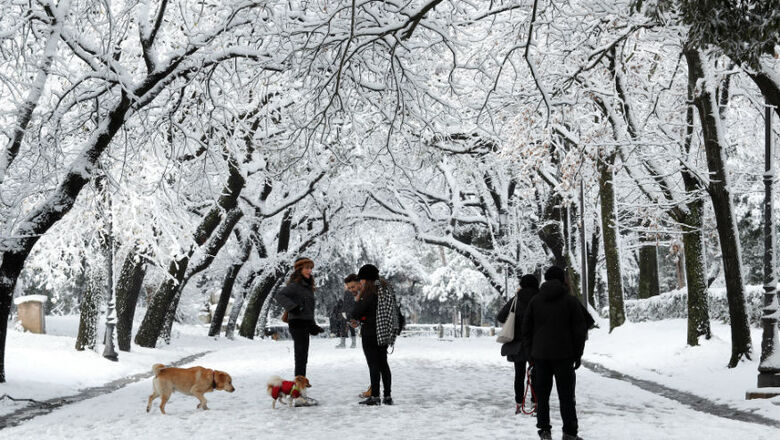
views
Oslo: A freak warming around the North Pole is sending a blast of Arctic cold over Europe in a sign of "wacky" weather that may happen more often with man-made global warming, scientists said on Monday.
On the northern tip of Greenland, the Cape Morris Jesup meteorological site has had a record-smashing 61 hours of temperatures above freezing so far in 2018, linked to a rare retreat of sea ice in the Arctic winter darkness.
"It's never been this extreme," said Ruth Mottram, a climate scientist at the Danish Meteorological Institute (DMI). Warmth was coming into the Arctic both up from the Atlantic and through the Bering Strait, driving and cold air south.
Around the entire Arctic region, temperatures are now about 20C (36°F) above normal, at minus eight degrees Celsius (17.6°F), according to DMI calculations.
To the south, a rare snow storm hit Rome on Monday and some Brussels mayors planned to detain homeless overnight if they refused shelter with temperatures set to fall as low as minus 10 Celsius (14 Fahrenheit) in the coming week.
Hit by easterly winds from Siberia, cities from Warsaw to Oslo were colder than minus 8C.
As long ago as 1973, a study suggested that an ice-free Arctic Ocean could make regions further south colder. That "warm Arctic, cold continent" (WAC#C) pattern is sometimes dubbed "wacc-y" or "wacky" among climate scientists.
"Wacky weather continues with scary strength and persistence," tweeted Professor Lars Kaleschke, a professor at the University of Hamburg.
"The question is whether this weather will happen more often. This is just one event so it's hard to make a causal relationship," he told Reuters.
SEA ICE SHRINKING
Scientists say a long-term shrinking of sea ice on the Arctic Ocean, linked to global warming, exposes warmer water below that releases more heat into the atmosphere. That in turn may be disrupting the high altitude jet stream.
"The jet stream becomes wavier, meaning that colder air can penetrate further south and warmer air further north," said Nalan Koc, research director of the Norwegian Polar Institute.
Arctic Ocean sea ice is at a record low for late February at 14.1 million square kilometres (5.4 million), according to the U.S. National Snow and Ice Data Center. That is about a million less than normal, or roughly the size of Egypt.
Erik Solheim, head of the U.N. Environment, said the rare weather fits a wider pattern driven by a build-up of greenhouse gases, mainly from burning fossil fuels from cars, factories and power plants.
"What we once considered to be anomalies are becoming the new normal. Our climate is changing right in front of our eyes, and we've only got a short amount of time to stop this from getting significantly worse," he told Reuters.
Under the 2015 Paris climate agreement, almost 200 nations agreed to limit a rise in temperatures to "well below" 2 degrees Celsius (3.5 Fahrenheit) above preindustrial times, while pursuing efforts to limit it to 1.5C (2.7F).
POLAR VORTEX
"The risk of an ice-free Arctic in summer is about 50 percent or higher" with warming of between 1.5 and 2.0 degrees, according to a leaked draft of a scientific report by a United Nations panel of scientists, obtained by Reuters.
The World Meteorological Organization said the chill in Europe was caused by a "Sudden Stratospheric Warming" above the North Pole that led to a split in the polar vortex, a cold area of air above the Arctic that spilled cold south.
A big problem in figuring out whether the Arctic warmth is driven by human activities or natural variations is a lack of measuring stations. There are no thermometers at the North Pole and satellite measurements go back only to the late 1970s.
On the Norwegian archipelago of Svalbard, temperatures were just above freezing, with rain, and about 13.4C (24F) above the long-term average on Sunday.
"There have also been recent winters with similar deviations," said Rasmus Benestad, senior scientist at the Norwegian Meteorological Institute.
U.S. President Donald Trump, who plans to quit the Paris Agreement, has often expressed doubts about mainstream global warming science during cold spells, such as at New Year in the eastern United States.
And Mottram at DMI said Europe's winters had become less severe. "It's not actually that cold. Its just our perceptions have shifted from a normal winter."













Comments
0 comment